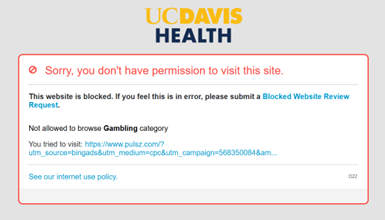Fighting threats from the web, IT implements new protection tool
Threat actors increasingly use tactics such as hijacking web addresses to redirect users to bad sites or sneaking malicious links on valid websites. These and other tactics are transparent and hard to catch, creating snares for anyone browsing.
To combat this, UC Davis Health Information Technology is implementing the Zscaler Internet Access (ZIA) protection tool.
What is ZIA?
The Zscaler Internet Access protection tool will reduce the risk of exposure to malicious web content on UC Davis Health endpoints (workstations).
ZIA reviews web content based on categorization, automatically restricting access to certain websites that are not permissible by policy or could be malicious. When attempting to visit such a site, a notification indicating that access has been blocked will be seen. This functionality is designed to enhance security awareness.

Note: If access to a blocked website is required for your business role, please contact the Technology Operations Center (TOC) for assistance.
ZIA Tool Implementation Schedule
The Cybersecurity team has been and continues to collaborate with numerous subject matter experts (SMEs) across various departments to test ZIA’s compatibility with web applications documented in UC Davis Health ServiceNow®.
The ZIA tool rollout begins on Tuesday, Feb. 25, 2025, and will continue over the following weeks. You will know that ZIA has been installed on your computer when you see the ZIA icon in your system tray (bottom right of your screen).

Need Assistance?
While we do not anticipate any issues with this implementation, if you do experience any problems with your web application after the ZIA client is installed, please report them to the Technology Operations Center at (916) 734-HELP (4357), or submit a service ticket. Need Help? - IT Self Service
Your support as we implement this essential security enhancement is appreciated. By adopting these measures, we can better safeguard our organization’s data and systems against modern cyber threats.





